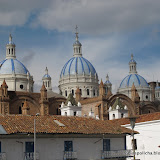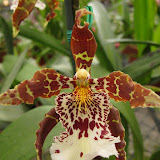So where were we………?
Ah yes, on the bus to Cuenca sucking down delicious coconut juice out of little plastic bags…..
Hhhmmmm.
So leaving the dry coastal forest, things quickly got greener passing into the coastal mountains, and by the time we reached the broad coastal plains it was rice fields and mango orchards.

Rice paddies
Leaving Guayaquil the approach to the andes was like coming up to a wall……
Flat, flat, flat, not flat!
The bus spent 2 full hours climbing to reach Cuenca (2596m = 8517ft).
Immediately the vegetation changed.
Clouds of ferns, dripping orchids.
Before dark, passed through the eerily subdued paramo, the high elevation moors.
The only trees in sight, scattered stunted, Polylepis. A rose family member that has the distinction of being tree that grows above ‘tree-line!’
The cool mountain air of Cuenca was welcome after a week of frying on the coast (although that was in itself a welcome respite from the month of soggy clouds…!).
Cuenca itself is a charming mountain city, with all architechtural appeal of Quito, without the smog, dirt and crime.

But the real reason I was there was to visit Ecuagenera!

1 of 23 greenhouses at this 1 of 3 sites!!!
A huge orchid grower and exporting business that has been around for over 20 years.
By propagating the 5000 species that they sell, from seed, they are alleviating pressure on wild populations that would otherwise suffer from over-collecting.
In 1993, Ecuagenera became the first Ecuadorian business to obtain permission to export orchids through the Convention on International Trade in Endangered Species (CITES).
They have used their success to promote conservation and education at various levels……
But this is not why I was interested........
Part of my dissertation research is to sample and map the fragrance chemistry of as many Dracula species as possible in an attempt to understand the evolution of the enigmatic mushroomy aromas that these plants use to attract pollinators.
So this was really a recon mission!
And it worked……I have been invited back to collect fragrances when i am finished teaching in may!

Porroglosum muscossum
While I was on the coast I read a book called ‘The Orchid Thief,’ on which the movie ‘Adaptation’ (which i have not seen) is loosely based.
It is a true story of a crazy plant freak trying to start an orchid nursery on a Seminole reservation in Florida by wild collecting ghost orchids from the swamps of the everglades.
It is really a wonderful history lesson on the extreme of the Victorian orchid craze, when privately-contracted orchid hunters, put higher value on their weaponry above all other tools.
A time of botanical looting and horticultural espionage.
It also gave a good insight into the quirks of the modern orchid collector scene, including lots of latin.
It was nice to be able to put a ‘face’ on many of the plants I had just read about!
Meanwhile I was being reminded of why everyone says “Don’t drink the weird juice in little plastic bags that they sell on the bus!”
And this with a 10 hour overnight trip back to Quito ahead of me!
I got a first-hand lesson in the power of activated charcoal to soak up extra intestinal liquid!!!
(thanks again Jesse)
Back in Quito,
Mostly getting ready to go back to Los Cedros, but did manage a hike in the Parque Metropolitano.

Dioscorea piperifolia (Dioscoreaceae)
A large city park, reminiscent of New York’s Central Park, or Vancouver’s Stanley Park.
A sprawling trail network amongst the introduced Eucalyptuses, did offer a glimpse into the original flora of this high inter-Andean valley (it still blows my mind that at 10,000 ft, Quito is in a valley!!!)

Botanical highlights included: an Oregon grape!!!! (Berberis hallii), a baby lady’s mantle (Lachemilla orbiculata), leaves the size of a quarter!!! A Sterculliaceae (chocolate family) that I had never heard of - Byttneria ovata, a weird spikey shrub. Dioscorea piperifolia a diminutive wild yam relative, and an apparently hallucinogenic shrub called ‘Shanshi’ that my friends aunt once misidentified as blueberries!!!!! (Coriaria ruscifolia (Coriariaceae)). Identification was refreshingly easy thanks to a recently published book “Flores Nativas de Quito.”

Berberis hallii
You can tell what is going on in local, national, and international politics by keeping your eyes open to the walls in Quito!
This visit coincided with International Women’s Day (which apparently is not celebrated in the states?), and the graffiti was apropos.

More soon…….
I should be working on the presentation I am giving at the Pontificia Universidad Católica del Ecuador on my research next week!!
Abrazos
Tobias
 |
| Cuenca to Quito |
Click on photo to see the whole slideshow
 |
| Ecuagenera Orchids |
Click on photo to see the whole slideshow





No hay comentarios:
Publicar un comentario